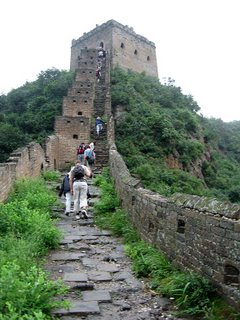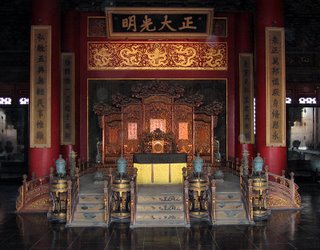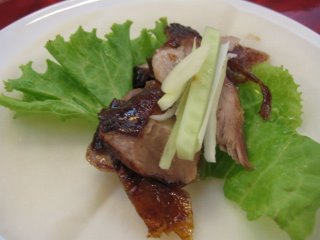"If you haven't been to the Great Wall, you are not a real man."
- Mao Zedong
7:20am – The tour bus rumbled through the streets of Beijing. Despite being full to capacity with 40 passengers, there was a strange quietness in the cabin. I double checked my supplies for the day – 2 bottles of water, 2 Pocari Sweats, a package of dried mango, some spicy dried beef, and a sleeve of Ritz crackers.
At a total length of about 5000km, the Great Wall of China stretches the equivalent length of Boston to San Francisco. From Beijing, there are several places where you can go to see it. The easiest, closest, and most popular place is the Badaling section of the wall, but this was not where I was heading.
The Great Wall was built over a long period of time, with the oldest sections being over 500 years old. As you may imagine, maintaining a structure of such magnitude is somewhat problematic. As a result, about 85% of the wall is currently in poor condition. For this reason, the Badaling section of the wall was restored about 50 years ago by the Chinese government – reconstructed to resemble its past glory so visitors could marvel at its splendor. Thousands of people come to visit this section of the wall every day. They feast on Chinese delicacies like… McDonalds? KFC? They go… shopping at the mall? Wait a minute… This wasn’t what I had in mind - I was hoping for something more… Old. Authentic. Raw. I wanted to see the real wall.
So I started to research my options. Many people described hiking along the wall as a way to get away from the masses of tourists and see some incredible sections of the unrestored wall. The
Simatai section was often cited as having the most spectacular terrain and scenery. Nearby was the
Jinshanling section, which appeared to be an “unspoiled” stretch of the wall with few tourists. I found a couple of outfits online that combined both areas into one outing, and seemed reputable and affordable. China Adventure advertised 3 options for a
one-day Great Wall hike:
1. Super Hiker – Get dropped off at the Jinshanling section and hike 10km to the Simatai section. Then, climb another 5km to the top of Simatai.
2. Regular Hiker – Same as #1, but skip straight to the parking lot at the end instead of scaling the Simatai portion.
3. Leisure Hiker – Skip straight to the Simatai section only, no hiking.
I was a little worried about the Super Hiker option. I am not a Super Hiker. But, this was my only trip to the wall, so I wanted to make the most of it. No one had forced me to decide yet, so as we were driving the 130km from Beijing to the wall, I was weighing my options. Even with no hiking, you would still get to see the real wall and spectacular scenery. The weather was cloudy and spitty, not the best for beautiful mountain vistas, but it would do. After 3 hours in a bumpy bus with 40 strangers, we had arrived at Simatai. The guide stood up and barked out in broken English something like “Anyone for no hiking get off now!” This was the moment of decision. I looked around to see what everyone else was going to do. I noticed a couple of guys maybe a little younger and a little skinnier than me jump up and say, “No hiking! That’s what I’m about!” They quickly ran out of the bus. This did not help my confidence. But everyone else stayed put - even the old lady. I was sure I could outwalk her. Before I could make up my mind, the bus drove away. Decision made, for better or worse. At this point, I tentatively titled this post “Rue the Day.” Mentally, I shifted gears and began to psych myself up for the hike.
We arrived at the Jinshanling section and got out of the bus. Since I was alone, I surveyed the crowd for some people who might be good to buddy up with (read: no triathletes or grandmas). The bus was going to be waiting for us at the Simatai section in about 4 hours and I didn’t want to lose my group and get left behind. Most of the people who came this day were couples, but there were a few loners like myself. As we hit the trail up the mountain to the wall, everyone kind of took off at their own pace. I just went with the flow, trying to make sure I stayed somewhere in the middle of the pack, remembering the faces of the other group members. My legs were already burning as we made the steep climb up the mountain to the wall. I kept thinking I was going to regret staying on that bus.
And then, all of a sudden, there it was. A few more steps, and I was standing on the Great Wall. I looked out and saw this continuous stretch of brick and stone, strung across the peaks and valleys of the mountains, snaking like the mythical dragon into the clouds. It was quite a sight.

Awesome view of the Great Wall.

Viva Pocari!
Like every other giddy tourist there, I began snapping photos at a dizzying pace. In every direction around me were bare mountains showing little evidence of human development. The thick clouds hung like a mist, giving an air of mystery and intrigue to the landscape. Buoyed by the spectacular view, I was reenergized and started walking.
Soon, the entrance disappeared behind me and the condition of the wall began to worsen somewhat (it seemed obvious that the entrance area must be fairly well maintained). The top surface of the wall was uneven with bricks broken and missing here and there. Wild vegetation was growing from the cracks between the bricks. The wall itself was not very wide – maybe about 10-15 feet at most, just enough for two people to walk comfortably side by side.
At first, the stretch of wall was fairly flat, sometimes slightly uphill, sometimes slightly downhill. However, as the nature of mountains tends to be, I soon came upon a steep climb. At this point, the wall became like a giant set of stairs. Navigating them was particularly tough because the steps were all different sizes. Some of the bricks were loose and unstable. And the steps were steep – some up to a 70 degree slope, making it tough to make it up without using your hands to steady yourself (more like climbing a ladder than stairs). At some points, the wall was in such poor condition that there were no sidewalls at all. I couldn’t help but think that there is no way they would allow access to a place like this in the States. Too many lawyers.
Watchtowers were located at regular intervals along the wall. Each one served as a marker of progress and offered a place to rest for a moment before continuing on. Up the stairs… Down the stairs… Up the stairs… Down the stairs…

A typical stretch of steps along the wall.

Some of the guard towers have been reduced to rubble.

There were lots of steep areas like this one.
After a couple of hours, I crossed into the Simatai section of the wall. It had begun to rain lightly, which was kind of refreshing given how hot I had been the day before. I was a little hungry so I stopped in a guard tower and pulled out my dried mango. I opened the package and grabbed a tantalizing piece of yellow… wait, brown mango flesh??? What was this garbage? I tasted it… Crap. It’s that nasty, sour, salted stuff. At least I have this jerkey… Hmmm, the dried pork(?) was hard and chewey with little redeeming flavor. Guess that’s what I get for not being able to read Chinese characters. Fortunately, anything tastes okay washed down with a little Pocari Sweat.
A while later, I reached a narrow footbridge suspended over a river. Walking across it was a little spooky – it was a small suspension bridge anchored to the sides of the mountains on either of the river. The floorboards were small wooden planks, and the bridge swayed back and forth with each step. On the other side of the bridge, was the path to the parking lot – I had made it! Of course, this brought on another decision – head to the bus, or continue to the top of Simatai.
The summit was shrouded in clouds, which meant that even if I was able to reach the top, I wouldn’t be able to see much. By now, the rain was steady and I was pretty wet. I still had an hour until the bus left, but my legs were not happy. Ahead of me was the longest, steepest stretch of steps that I had come across on the hike. These steps were serious. These steps were pain. Nevertheless, I had come this far, so I decided to give it a try

The impressive Simatai section of the Great Wall.
Slowly and deliberately, I trekked up the stairs. My legs burned with each and every step. I could only go a short while before having to stop and catch my breath. I hit the first guard tower, which was pretty high up. Just past the tower was a short stretch of stairs that leveled out on a ridge for a bit before shooting straight up to the top. I checked the time – 40 minutes till bus departure. Even if I were to make it to the top, I would still have to turn around and come back. I just didn’t have the time. I headed up to at least hit the ridge so I could see the view before I headed back down. There I stood, at the edge of the clouds, watching the wall dance across the mountains, disappearing in the mist. Standing there alone in the pouring rain, I raised my hands to the heavens and let the wind and rain kiss my face. What an experience.

The steep climb to the first Simatai guard tower.

The view from the highest point I hit. I had hiked across all of the wall visible in this photo. Hope the wind doesn't blow my camera over the side!
I climbed back down the stairs carefully – the rocky steps were steep and very slippery. On the way to the parking lot, I stopped at a small souvenir shop and picked up a cheesy “I climbed the Great Wall” T-shirt for $2. What a deal. The thunderstorm continued, but at this point, I was already completely soaked through, so it didn’t really matter. I found the bus, climbed on, and collapsed in my seat. I was so glad to be still. I had survived the day, and was anxious to get back to the hotel and crash. In 3 short hours, I would be there.
Well, almost.
The first sign of trouble was when we pulled out of the parking lot of Simatai and traffic on this small two lane road was at a dead stop. We waited about 10 minutes without moving when the driver decided to make a U-turn. With a tour bus. Did I say it was a two lane road? After another 10 minutes (spent coercing the cars behind us to move, and then executing the turn), we headed back towards the parking lot. This time we went out the back way. I had no idea if it would actually be faster or not, but since we were moving, it at least felt like progress. About 15 minutes later there was a very loud bang on the back right side of the bus, followed by a mass turning of heads and furrowing of brows. The driver pulled over to inspect the damage. “Flat tire,” he said as if it were no problem at all (I should point out that this bus had the dual tire configuration, so there was still one good tire left on that side). He climbed back in the driver’s seat and continued down the road. A couple of minutes later, we began to hear a thump-thump-thump-thump sound coming from said tire. It seemed to be increasing in frequency and loudness as the speed of the bus increased. We had no choice at this point, the tire would have to be fixed.
The problem was that we were in an area of small villages with modest brick houses, where corn fields, bicycles, and dirt paths were more common than more modern things, like for example, auto parts. We pulled over on the side of the road near this small building that had handwritten signs posted on the outside.

Apparently this sign says something like, "Tire Repair." I'm not making this stuff up.
The driver got out and put a piece of wood behind the rear wheel. He then backed the bus up onto the wood, suspending the bad tire in the air. At this point, the bus emptied as all of us passengers had to get out and take a look at the damage. The driver went to talk with one of the villagers, who then went into one of the small buildings and extended a compressed air hose out to the bus. Then, he connected a massive air-driven torque driver to unscrew the bolts from the wheel. What do you know, I guess they do have auto shops out there! As the mechanic worked to remove the wheel, shutters clicked and flash bulbs strobed as all of us curious passengers supervised the proceedings. Everyone got quite a chuckle out of the situation. Fortunately, the bus was equipped with a spare tire and within 15 short minutes, we were ready to roll again. I got back on the bus and realized that it was warm, humid, and stunk like a locker room. Only 3 more hours.

The busted tire and the "jack"

A village boy plays outside.
There was an interesting mix of people in the group. It seemed that of all the people there, I was the short timer – “You’ve only been in China for two weeks?” Well ‘scuse me people. I also was one of the precious few who were staying in an actual hotel. There were scores of crunchy earth, hostel-going euro types. I only ran into one or two other Americans. There were Aussies, Germans, Danish, Norwegians, Brits, Italians, Canadians and Belgians to name a few. Everyone was extremely friendly. On the wall, I had met a German software manager who was in his 9th month of a 2 year assignment living in Beijing and a Canadian couple living in Beijing teaching English. On the bus, I sat next to a Norwegian seismologist who had just spent two weeks in Tibet and was one of the very first to travel on the new
high altitude train to Lahsa. There was a Belgian girl who had traveled from Europe via the Trans Siberian Railroad. There was a foreign-born Chinese girl who had made the long trip to Asia to learn about her heritage. A British woman had brought her 7 year old son who kept asking “Are we almost done?” And there was a young Belgian couple who had spent a month in China traveling around the country, planning each day only as it arrived. All of these people I spent some time with as I made my way along the wall and on the bus.
Eventually, I arrived at the drop-off for the subway station. I said goodbye to my new friends and hopped off the bus. I’m sure the other train passengers weren’t happy to have a wet stinky tourist on board with them, but I was thrilled to be heading “home.” It was after 10pm by the time I reached the hotel. I was dead tired, soaking wet, and in desparate need of a foot transplant. As I opened my backpack and started unpacking my stuff, I realized that everything inside was soaked through. I lost some postcards, a nice Beijing guide book, and had a scare with my passport. Oh well, nothing I could do about that stuff now. I got cleaned up and changed and hit the pillow hard. Needless to say, I slept like a rock.
 The Forbidden City, or Imperial Palace ('Gu Gong' for all of you wannabe Mandarin scholars), was the residence of China's emperors from 1420 until the fall of the dynasty system in the early 1900's. Located in the direct center of old Beijing, many emperors did not leave these grounds at all throughout their entire lives. Like everything else in Beijing, it's big - really big. Check out this satellite photo. For reference, you can see Tiananmen Square (remember, 82 football fields big) in the lower half of the picture.
The Forbidden City, or Imperial Palace ('Gu Gong' for all of you wannabe Mandarin scholars), was the residence of China's emperors from 1420 until the fall of the dynasty system in the early 1900's. Located in the direct center of old Beijing, many emperors did not leave these grounds at all throughout their entire lives. Like everything else in Beijing, it's big - really big. Check out this satellite photo. For reference, you can see Tiananmen Square (remember, 82 football fields big) in the lower half of the picture.






























